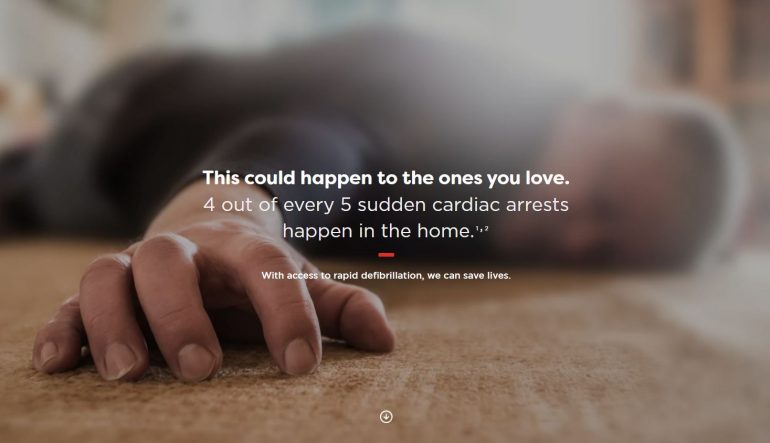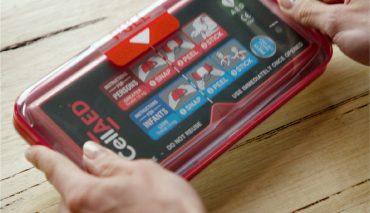Donovan Casey – co-founder and CEO, Rapid Response Revival
This week, CellAED is going to Europe.
As I write, my exceptionally talented colleagues are putting the final touches on cellaed.io (pictured), our online shop for European pre-orders of the next-generation AED that will revolutionise how the world responds to out-of-hospital cardiac arrest.
Since we secured CE Certification for CellAED earlier this year, this team has moved mountains.
Thanks to them, we are about to offer world-first access to CellAED to the 27 nations that make up the European Economic Area.
Buying time
When they were first made available for public use in 2004, AEDs were a godsend. These devices suddenly put the power to save a life in the hands of people with no medical training, but who needed to be able to act quickly to buy time in the event of a cardiac arrest.
This is what it’s about – buying time to save a life.
For every minute following a cardiac arrest without CPR or defibrillation, a patient’s chances of survival drop 10 per cent. If it takes an ambulance more than 10 minutes to arrive to an untreated patient, that person won’t survive.
AEDs give bystanders the best possible chance to save a life from sudden cardiac arrest.
AEDs are brilliant tools, when they’re close enough to be used in time to save someone following a cardiac arrest.
The fact that globally, the survival rate is below one per cent, tells us this doesn’t happen very often.
One reason for this is that more than 80 per cent of out-of-hospital cardiac arrests occur in homes.
Today’s AEDs are too expensive to be a realistic option for households of people who are at risk of cardiac arrest.
This means, the tools that provide the best chance of surviving an out-of-hospital cardiac arrest are unlikely to be located where they need to be – in our homes.
From public, to personal
When we achieved CE for CellAED, I wrote about why we invented this device.
We started this business with the ambition of creating an AED that is easy to use in the high-stress moments following a cardiac arrest, by bystanders with no medical training.
We needed this AED to be compact and lightweight, and always ready-to-go. This meant that no extra assembly would be required in those critical minutes when someone is trying to save a life.
This device also needed to be something a regular household could afford.
CellAED has achieved all of these ambitions, and more.
The first customers for CellAED will be getting access to a personal defibrillator that is up to one-tenth of the price of other AEDs.
A big part of what makes CellAED unique, is the fact it can be applied in seconds. With Snap, Peel, Stick, CellAED can be deployed rapidly, and easily.
RELATED ARTICLE: How many lives can we save?
In exceeding these benchmarks we set for ourselves, we have created a tool that has the potential to save millions of lives around the world.
So much to do, so little time
On the eve of us making CellAED available for the first time, I’m reminded of how far we’ve come – and how quickly.
In 2017, we formed the company to design, create and build the world’s first personal defibrillator.
In 2018, we took early prototype to Medica, the world’s largest medical trade fair, in Germany. We were absolutely swamped with interest; later, we learned from the organiser that ours had received the highest traffic of any stand at the show.
That was the moment we knew, what we had created was really special.
Fast-forward to today – and it has very much felt like a fast-forward.
One a week, without fail, every member of Rapid Response Revival comes together for lunch.
This has been a virtual affair for much of 2020 and 2021 in the midst of pandemic lockdowns. If anything, that has democratised somewhat our weekly gatherings, as our people who are located in various parts of the Asia-Pacific region down-tools and tune in.
The sense of excitement at what we are about to do has been building week-on-week, as we’ve careened our way closer to this moment.
Personally, I have nothing but admiration and respect for the individuals and teams that have helped us reach this point.
From those early days prototyping with my fellow founder, Erol Teber – to today, where as usual in this business, the efforts of a few have delivered an output that would require hundreds of pairs of hands anywhere else.
To the Rapid Response Revival team – this is your achievement.
Because of you, people who would otherwise have died, will survive.
Donovan Casey is co-founder and CEO of medical technology startup and creator of CellAED, Rapid Response Revival. Follow Donovan here.
DISCLAIMER: CellAED is approved for use in the member states of the European Economic Area. If you would like to be kept informed on when regulatory approval has been secured for your location, register your interest here.



